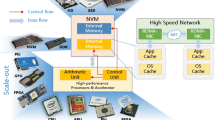Abstract
Using off-the-shelf distributed database management systems, distributed database developments have significantly proliferated. The data allocation design is an essential factor affecting the efficiency and effectiveness of a disturbed database in meeting geographically dispersed database processing demands. Data allocations in local area networks (LANs), metropolitan area networks (MANs), and wide area networks (WANs) are subject to different requirements and considerations. In particular, the primary incentives for distributed database implementations in a LAN are load balancing and distributed computing, while the development of distributed databases in a WAN is mainly motivated by the notion of locality of reference. MANs benefit from both balanced nodal processing loads and maximized local access. Furthermore, the performance levels and cost structures in LANs, MANs and WANs are different. Moreover, LANs, MANs and WANs exhibit distinct network control and medium contention schemes. This paper analyzes the unique considerations and requirements for data allocation in each type of network and further examines the impact of network environments on the structures and the effectiveness of optimal data allocation models.
Similar content being viewed by others
References
P.M.G. Apers, Data allocation in distribution database systems, ACM Trans. Database Syst. 13 (1988) 263–304.
R.G. Casey, Allocation of copies of a file in an information network,Proc. AFIPS Spring Joint Computer Conf., vol. 40 (AFIPS Press, Montvale, NJ, 1972) pp. 617–625.
S. Ceri, B. Pernici and G. Wiederhold, Distributed database design methodologies, Proc. IEEE 75 (1987) 533–546.
S.-K. Chang and W.-H. Cheng, A methodology for structured database decomposition, IEEE Trans. Software Eng. SE-6 (1980) 205–218.
G.H. Clapp, Broadband ISDN and metropolitan area networks,Proc. GLOBECOM'87 (1987) pp. 2049–2054.
L.W. Dowdy and D.V. Foster, Comparative models of the file assignment problem, Comput. Surveys 14 (1982) 287–313.
K.P. Eswaran, Placement of records in a file and file allocation in a computer network,Proc. IFIPS Conf. (1974) pp. 304–307.
M.R. Garey and D.S. Johnson,Computers and Intractability: A Guide to the Theory of NP-Completeness (Freeman, San Francisco, 1979).
B. Gavish and O.R. Liu Sheng, Dynamic file migration in distributed computer systems, Comm. ACM 33 (1990) 177–189.
P.E. Gill, W. Murray and M.H. Wright,Practical Optimization (Academic Press, New York, 1981).
A.R. Hevner, Data allocation and retrieval in distributed systems, in:Advances in Data Base Management, vol. 2, eds. E.A. Unger et al. (Wiley Heyden Ltd., 1984).
H. Lee and O.R. Liu Sheng, Optimal data allocation in a bus computer network,Proc. IEEE Int. Phoenix Conf. on Computers and Communication (1990).
O.R. Liu Sheng, Database allocation in Ethernet-based local area networks: a queueing analytical approach,Proc. Hawaii Int. Conf. on System Sci. (1989) pp. 733–742.
O.R. Liu Sheng, Performance analysis of distributed database processing in bus local networks, INFOR 28, no. 3 (Aug. 1990) pp. 201–220.
O.R. Liu Sheng and H. Lee, Formal analysis of data allocation design in distributed relational database systems, Working paper, University of Arizona (1991).
O.R. Liu Sheng and H. Lee, Data allocation design for LANs under weak locality of reference, Working paper, University of Arizona (1991).
R.E. Marsten, ZOOM User's Manual, Release 4.0, Department of Management Information Systems, University of Arizona (1987).
J. Martin,Data Communication Technology (Prentice-Hall, Englewood Cliffs, NJ, 1988).
J.F. Mollenauer, Standards for metropolitan area networks, IEEE Trans. Commun. COM-26 (1988) 15–19.
P.A. Morreale and G.M. Campbell, Metropolitan-area networks, IEEE Spectrum 27 (1990) 40–42.
C.V. Ramamoorthy and B.W. Wah, The isomorphism of simple file allocation, IEEE Trans. Comput. C-32 (1983) 221–232.
J. Singhal, R.E. Marsten and T.L. Morin, Fixed order branch-and-bound methods for mixed-integer programming: the ZOOM system, ORSA J. Comput. 1 (1989) 44–51.
W. Stalling,Local Networks (Macmillan, New York, 1987).
W. Stalling,Data and Computer Communications (Macmillan, New York, 1988).
A.S. Tanenbaum,Computer Networks (Prentice-Hall, Englewood Cliffs, NJ, 1988).
B.W. Wah, File placement on distributed computer systems, IEEE Trans. Comput. C-17 (1984) 23–32.
B.W. Wah and Y. Lien, Design of distributed databases on local computer systems with a multiaccess network, IEEE Trans. Software Eng. 5E-11 (1985) 606–619.
E. Wasil, B. Golden and L. Liu, State-of-the-art in nonlinear optimization software for the microcomputer, Comput. Oper. Res. 16 (1989) 497–512.
Author information
Authors and Affiliations
Rights and permissions
About this article
Cite this article
Liu Sheng, O.R., Lee, H. Data allocation design in computer networks: LAN versus MAN versus WAN. Ann Oper Res 36, 125–149 (1992). https://doi.org/10.1007/BF02094327
Issue Date:
DOI: https://doi.org/10.1007/BF02094327




